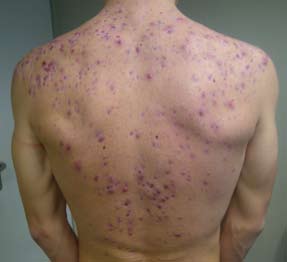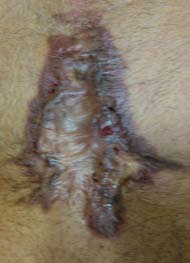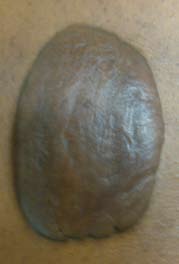Drrakesh1.yellowleads.co.za

A Brief on Scars:
Good, Bad and Ugly
Our skin acts as a barrier to the external environment. It pro-
Common causes of disruption
tects us from fluid loss, bacteria and other harmful organisms
to the skin
from entering our body and also from the harsh atmosphere surrounding us. It has several other functions like tempera-
ture control, toxin elimination and hormone production,
among others. Covering a surface area of around 2m2 in an
adult, it is very vulnerable to external injuries. These injuries tend to heal in various ways and leave unsightly scars.
• Skin diseases, eg. lupus, morphea, chicken pox
The skin is composed of two layers: the epidermis and the
• Acne vulgaris
dermis. Below those layers is the subcutaneous fat. The skin
• Acne keloidalis nuchae
appendages, like the hair follicles, sweat glands and seba-ceous glands are located in the dermal layer and the colour producing cells, called melanocytes are located in the dermo-
Thereafter, the wound tends to mature and remodelling starts.
epidermal junction. This anatomy is very important as the
This can last for a few years. Factors affecting wound healing
deeper the injury and the more the appendages are destroyed,
are listed in table 2.
the more scarring will occur. The different causes of injuries are listed in table 1.
Good and bad scars
A scar is formed when the deep, thick layer of the dermis is damaged. The scar never completely goes away, but can
Different types of wounds heal in different manners, depend-
improve with time and various other factors. A good scar is
ing on the size of the skin defect and measures taken to aid the
thin, flat and pale with a minimal trace of the original injury.
A bad scar is raised or recessed, dark in colour and/or
1. Primary
intention: Apposition of skin surfaces of fresh
extends over the boundary of the original injury. The majority
wounds. This can involve suturing, skin flaps, grafts.
(75%) of all scars will go through hypertrophic or exaggerated
2.Secondary
intention: Wounds are left open and allowed
scarring if not adequately managed. Thus every scar deserves
to heal naturally by epithelialisation with granulation and
iary intention: The wounds are closed a few days
Scar types
Wound healing is an intricate process in which the skin
Various insults to the skin lead to different types of scars.
repairs itself after the injury. There is a complex set of bio-
Common types of scars include pigmentary disorders, hyper-
chemical events that starts as soon as the injury is sustained
trophic and keloidal scars, atrophic scars, contracture scars,
and can continue for years.
depressed scars and stretched scars. These scars can depend
The first stage is to form a fibrin clot to prevent further
on the type of healing, skin colour, genetic factors and the site
bleeding. Thereafter the injury goes through various phases
of inflammation, where the debris and bacteria are phagocy-tosed and removed by various cells that migrate to the area.
The proliferative phase starts soon after where new blood
Excessive wound healing results in two types of scars: either
vessels are produced and new collagen fibres are deposited.
keloids or hypertrophic scarring. Keloids tend to be more common in non-white races and occur mainly in the upper
About the author
body. It is characterised by excessive tissue formation during
Dr Rakesh Newaj is a Specialist Dermatologist in private practice at Arwyp
wound healing that goes beyond the borders of the injury.
Medical Centre, Kempton Park, Gauteng. His special interests include general
Keloid formation may have a genetic predisposition. In many
dermatology, diseases of the hairs and nails, genital skin diseases as well as
patients, it can be disfiguring and it is very challenging to
well treatment of severe skin conditions. Dr Newaj may be contacted via www.
july 2014 / MODERN MEDICINE 13




A BrIEF On SCArS: GOOD, BAD AnD UGly (c0ntinued)
Hyperthrophic scar post surgery.
Acne vulgaris with severe scars.
joints (elbow, knee, etc.). Scars from excisional wounds on the trunk and limbs often stretch too. When the skin is burnt, a
Hypertrophic scar is a raised, red scar, similar in appearance
scar will form causing tightening of the skin. This scar may go
to a keloid, but it does not extend over the injury site. This
deeper to affect muscles and nerves. If the scar limits move-
scar is formed when there are high areas of tension with ‘pull-
ments of the body (usually over joints) it is referred to as a
ing forces' in many directions, eg, sternum and back. It tends
scar contracture.
to improve with time.
Sunken scars
Usually when one suffers from severe acne or chicken pox,
Stretched scars occur when there is increased tension in one
scars are formed as a sunken recess in the skin giving it a pit-
direction on the skin or scar area, eg, in injuries such as the on
ted appearance. These are caused when underlying structures supporting the skin, such as fat or muscle, are lost.
Table 2
Factors affecting wound healing
Prevention and avoidance
All injuries to the skin will heal with scar formation. Most
• Age ( decreased protein turnover, diabetes, etc)
can be made cosmetically pleasing; however, some can be
• Malnutrition ( vitamins C, A, zinc, copper)
unsightly. One should decrease the probability of scars by performing unnecessary procedures. Early treatment of skin
• Systemic diseases (anaemia, diabetes, neuropathy)
diseases like acne, lupus or chicken pox will decrease scars. In
• Cytotoxic drugs and steroids
addition, when treating a wound, good wound alignment and
prevention of tension, use of silicone gels from the beginning
• Genetic conditions (Marfan's, Ehlers-Danlos)
(hydrates and help the wound to heal faster) and prevention of infection, can all assist in limiting scars.
• Site: Wounds of head, neck and hands always heal well.
Good blood supply and abundant adnexal cells
Scars are best prevented by limiting unnecessary surgeries,
• Tension on tissues: Inhibits blood supply leading to
proper and early treatment of skin lesions. Patients need to
be individualised with several factors considered. Age, area
• Local infection
involved, type of scar and skin types are taken into account
• Poor blood supply
when formulating a treatment plan. If used early enough, silicone gels and retinoid creams can be very effective in most
patients. Other treatment modalities involve the use of chemi-
cal peels, subcision and/or fillers as well lasers to assist in the
• Local radiation
improvement of scars. Keloids tend to be the most challenging
• Occlusion: Decrease chance of infection and keep it moist
of all and may need to be treated with the injection of 5-fluo-
• Presence of dry eschar
rouracil or triamcinolone. At times, excision and radiotherapy can be successful in resolving unsightly lesions.
14 MODERN MEDICINE / july 2014
Source: http://drrakesh1.yellowleads.co.za/image.ashx?i=25862.pdf&fn=undefined
Dr. Stephan Madaus Vertreter des Lehrstuhls für Bürgerliches Recht, Deutsches, Europäisches und Internationales Unternehmensrecht (Prof. Dr. Horst Eidenmüller, LL.M.) Übung im Bürgerlichen Recht für Fortgeschrittene Übungsfall Biologieprofessor P. hat von einer Reise nach Südkorea Ginseng-Wurzeln mitge- bracht, die er einem befreundeten Pharmakologen zu Forschungszwecken zur Ver-
[12] UNNI 4-19-12.DOC (DO NOT DELETE) 9/10/2012 3:01 PM Indian Patent Law and TRIPS: Redrawing the Flexibility Framework in the Context of Public Policy and Health V.K. Unni Presented in March 2011 at the University of the Pacific, McGeorge School of Law Symposium on The Global Impact and Implementation of Human Rights Norms. TABLE OF CONTENTS












